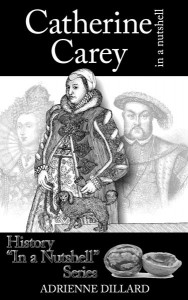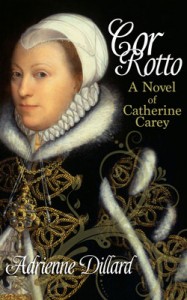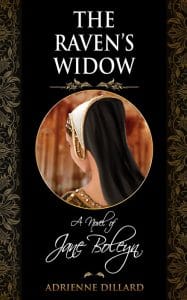 On this day in history, 26th April 1540, Catherine Carey, daughter of Mary Boleyn and niece of the late Queen Anne Boleyn, married Francis Knollys.
On this day in history, 26th April 1540, Catherine Carey, daughter of Mary Boleyn and niece of the late Queen Anne Boleyn, married Francis Knollys.
Thank you to Adrienne Dillard, author of two books on Catherine Carey – the novel Cor Rotto and the non-fiction book Catherine Carey in a Nutshell – as well as a wonderful novel on Jane Boleyn, The Raven’s Widow, for sharing this extract from her non-fiction book.
In Tudor England, more often than not, marriage in the nobility and upper classes was the result of very careful dynastic planning on the part of two families looking to consolidate their interests. It also seems to have been very rare for a courtship to have organically grown between two people out of their own volition. Two people could form affectionate bonds before marriage, but those bonds usually came about because they were already promised to each other or there was an expectation that they would be. It wasn’t impossible for two people to fall in love and get married, but it was definitely the exception and not the rule. Sometimes there wasn’t even time for a courtship. Marriages could be arranged and consummated in a matter of weeks. Fortunately, there was always a chance that the two strangers who found themselves at the altar would grow to deeply love and respect each other as if they were soulmates. It is unknown whether the marriage between Francis Knollys and Catherine Carey was the result of a love match or a very lucky arrangement, and the primary documents don’t reveal many clues.
While there is no clear evidence of Catherine’s whereabouts from her birth to around age fifteen, it is documented that Francis sat for parliament before he was appointed to the king’s bodyguard in 1539 and, though there is no official record of it, tradition says that he attended Magdalen College, so it is likely that he was around his childhood home of Rotherfield Greys in Oxfordshire for most of his youth. It seems then that the two might have met in November 1539. Both appear in the Letters and Papers of Henry VIII. Francis is listed as one of the men sent to greet the king’s fourth wife, Anne of Cleves, upon her arrival at Calais and Catherine is listed as one of the maidens ready to meet Anne once she arrived at court. There aren’t any obvious links between the two families, but Catherine’s stepfather, William Stafford, is listed in the same welcoming group as Francis. The papers show that Catherine was listed in the group set to meet the queen at Dover, so it is unlikely that they travelled over together if Catherine was living in Calais at the time. She either came over earlier than Francis and her parents or she was already living somewhere in England with her mother. Perhaps William Stafford was so impressed with Francis during their journey together that he instigated a meeting between the two in the hope that they would hit it off. But it can’t be ruled out that their marriage was one that was engineered by either the families of Francis and Catherine or by the king.
However Francis and Catherine became a couple, their courtship did not last long. They were married on 26 April 1540 and their first son, Henry, was born less than a year later. The Latin dictionary held in a private collection of a Knollys descendant can offer some clues into the relationship between husband and wife. Francis’s Latin dictionary is the first volume in a set and contains the letters A to E. Researcher Sally Varlow notes that it was produced in Venice in 1551 and is still in its original calf binding. She indicates that Francis most likely picked it up while he was in exile in the Low Countries. The introductory paragraph notes the date of the Knollys’ marriage and describes how the writer dated the entries. It goes on to list the names and dates of birth of all fourteen of the Knollys’ children.
Here folowethe in order the names, wt the tymes
of the byrthe of the chyldren of Francys Knollys
& Katern his wyff e that were maryed ye xxvi daye
of Aprylle anno. 1540 & the year of or Lorde is
cownted to begyne at kyrstmas.
Varlow’s analysis of the handwriting shows that the introductory paragraph and first eleven entries, along with the number twelve, were written at the same time. The twelfth and thirteenth births were recorded together as well in the same hand. The final birth may have been recorded by someone else. When compared to the confirmed handwriting of Francis, the first thirteen entries appear to have been written by him. Since a time of birth is included for the last two births, one could surmise that Francis, himself, was present. While this is not completely out of the ordinary, it does support the idea that Francis and Catherine had a close relationship and he attended at least some of the births when he was able.
 Adrienne Dillard is a graduate with a Bachelor of Arts in Liberal Studies with an emphasis in History from Montana State University-Northern. Adrienne has been an eager student of history for most of her life and has completed in-depth research on the American Revolutionary War time period in American History and the history and sinking of the Titanic. Her senior university capstone paper was on the discrepancies in passenger lists on the ill-fated liner and Adrienne was able to work with Philip Hind of Encyclopedia Titanica for much of her research on that subject. Her works include best-selling novels Cor Rotto: A Novel of Catherine Carey, The Raven’s Widow: A Novel of Jane Boleyn and the non-fiction Catherine Carey in a Nutshell for MadeGlobal’s History in a Nutshell series. When she isn’t writing, Adrienne works as an administrative assistant in the financial services industry and enjoys spending time with her husband, Kyle, and son, Logan, at their home in the Pacific Northwest.
Adrienne Dillard is a graduate with a Bachelor of Arts in Liberal Studies with an emphasis in History from Montana State University-Northern. Adrienne has been an eager student of history for most of her life and has completed in-depth research on the American Revolutionary War time period in American History and the history and sinking of the Titanic. Her senior university capstone paper was on the discrepancies in passenger lists on the ill-fated liner and Adrienne was able to work with Philip Hind of Encyclopedia Titanica for much of her research on that subject. Her works include best-selling novels Cor Rotto: A Novel of Catherine Carey, The Raven’s Widow: A Novel of Jane Boleyn and the non-fiction Catherine Carey in a Nutshell for MadeGlobal’s History in a Nutshell series. When she isn’t writing, Adrienne works as an administrative assistant in the financial services industry and enjoys spending time with her husband, Kyle, and son, Logan, at their home in the Pacific Northwest.
You can find out more about Adrienne and her books at viewauthor.at/adriennedillard.


She could have been Henry V111’s daughter, in her book ‘Mary Boleyn The Great And Infamous wh*re’ Weir says there is a very strong likeness around the eyes between herself and Henry V111, the picture which is featured on the cover of Adriennes book, having studied Catherines portrait in the past with one of a young Henry V111, I can see an actual likeness there, her marriage was a long and successful one and she was very fertile, giving birth to one daughter Lettice who grew up to become Elizabeth 1st’s rival for the affections of Robert Dudley Earl Of Leicester who she eventually married, Elizabeth adored her cousin who could well have been her natural half sister as well, if Catherine was the daughter of Henry V111 then she had not inherited the Tudor barren genes and she has thousands of descendants today, in America as well as England and many of then are notable descendants as well. Darwin Nelson and Churchill amongst them, on the other side of the pond are the De La Warre’s and Wests, some say Catherine had been in attendance on her aunt in the Tower but there is no actual proof of this, she has a magnificent Tomb in Westminster Abbey proof of the queens devotion and love for her, likewise her younger brother Henry, because her mothers whearabouts are not known during her second marriage with Stafford and in fact, most of her life, we only know she must have been in attendance on her sister some time, but her life is shrouded in mystery, we do not know when her affair with Henry began or when it ended, we know as a young girl she was sent to France possibly with Anne and we know her first husband died of the sweat very tragically, if he had been Catherines father than sadly she could probably barely remember him, and if her father was Henry V111 it must have been a closely guarded Boleyn family secret therefore she could never call him her father and was never acknowledged by him, it is something which people have debated on for centuries, has Henry V111 got living descendants today, it’s a fascinating thought to think that he could well have, sadly I think it’s a question that will remain unanswered for infinity.
I know this was a good match and an arrangement, as most were but you don’t have sixteen children with a husband you have no or little affection for, you have a few children, a couple of sons to give them an heir with a good chance of survival and a couple of living daughters. Francis and Katherine were very lucky as most of their children lived. With so many children living they had a good investment in the future. There must have been some love or deep affection to go on having children even when the need to passed. They were not trying to replace children who had died, so this is a couple who had sexual relations because they wanted to on a regular basis and babies were the natural result.
Maybe this points to Catherine not being the child of Henry Viii, whose progeny were not healthy and did have conception problems. She was also a Boleyn, who had slightly better odds when it came to kids, but who also failed to leave a legacy of children, male children at any rate. George Boleyn had none and Mary had two and Anne only one. So Catherine was very fortunate to be so fertile. She was also very fortunate to have so many healthy children, so perhaps she was a particularly healthy individual. Her husband’s family of course probably had a better gene pool for health. The fact is we don’t really know why Henry had such a poor rate with children but a number of reasons have been proposed from poor diet, something wrong with his or his wife’s blood to genetic complications. Theories ate fascinating, but without a body to look at or the blood to test, we can’t answer the mystery with any certainty. Without DNA we can’t even prove parentage.
Historians who supported the idea that Catherine Carey was the daughter of Henry Viii usually point to two things, the timing of the birth v relationship with Mary Boleyn and grants made to William Carey shortly after the birth of each child. Now, while this may be more than a coincidence, it is not proof of parentage and there are other explanations, such as Sir William being the King’s friend and in service to him for many years and we don’t actually know how long or when Mary was Henry’s mistress. It might have lasted a few months or two years or he might have had two one night stands which resulted in two pregnancies. Now that would be some coincidence! The only evidence that Henry even slept with Mary Boleyn is also sketchy. Henry cites an unnamed relative he has slept with in his original suit to the Pope for a dispensation to marry Anne Boleyn. Now unless there are several Boleyn women around the Court of the right age, this is Mary, her sister. Henry in a reverse suit annulled his dead marriage to Anne based on his relationship with her sister, one day before Anne’s execution. Mary, herself appears to confirm that she was known to have slept with both King Francis and King Henry. We also have a Shrove Day ddvice which dates from the time associated with a relationship between Mary and Henry. Catherine Carey being conceived coincides with this period. So, by deduction Catherine could be the daughter of Henry Viii.
Catherine Carey lived a very long life and she and her husband served Elizabeth I who then made certain she had a very grand tomb. A very brief book has been written by Adrienne Dillard and another brief bio by Sarah Beth Watkins. What is needed is a long researched, meaty in depth study of Catherine Carey which seeks to answer some of the mystery, if possible. (Just to add my instinct tells me she was Henry’s daughter, but my guts are not proof, unfortunately).
I tend to swerve more towards Henry being her father than Carey because there does seem to be a similarity between her and the King, and also Weir notices she has a jowly face like Elizabeth Of York, Elizabeth’s portrait in her latter years showed her as having gained some weight and in Catherine’s portrait painted when she was pregnant there again is a similarity round the jawline, her tawny colouring is very evident under her cap which was distinctive amongst the Tudors and Weir notices she has the same arched brows which Henry V111 also possessed, the grants made to William Carey some point towards proof that yes, it was a reward for bringing up his daughter and having his name, but as mentioned Carey was a close cousin and friend of the King so it was perfectly natural to bestow grants on him, and Henry was very generous to his friends anyway, we have only one portrait of Carey and it shows he was a nice looking man his hair looks brown but it could have had auburn tints in it, because he was a relation to Henry it would be perfectly normal for Catherine to resemble the King as well, but she does seem to look like Henry and to be honest I cannot see any resemblance to Carey at all, there is the fertility issue to, all Henrys offspring had poor health, both Fitzroy Edward V1 and their uncle Prince Arthur all died from what sounds suspiciously like the same disease, but Arthur’s wasn’t long drawn out and his sudden death was a dreadful unexpected shock, at his wedding he was described as being not of a very strong constitution, ( my words), with Edward he was ill for many months and his death was expected when it became clear his doctors could not treat him, he was coughing up green matter and broke out in sores and ulcers, the poor lad could have died from a pulmonary infection which is one theory, TB is another theory, Fitzroy seemed to just waste away with symptoms which sound similar and Mary suffered from migraines and painful periods and depression/ anxiety brought on by her parents break up, which did nothing for her state of health, and died from what could have been stomach cancer, Elizabeths health was up and down throughout her life, rather delicate she suffered from headaches and palpitations of the heart, but she could walk for hours and loved hunting and could dance all night, she nearly died from smallpox but managed to pull through, her laundresse’s noted she had little or very few periods and she like her siblings never had children, she was nearly 70 when she died and a good age for the time, when we consider the large family Catherine had she was extremely lucky, because if she was half Tudor then the genes which were a curse to her father escaped her entirely, her grandfather Thomas Boleyn came from a large family so she could well have inherited her fertility from the Boleyns, I know a lot of Catherines and her brothers descendants would love to know for certain who their father was, I think there is no doubt who Henry Carey’s father is, his paternity should not be in question, but Catherine is a mystery, maybe she knew who her father was as Mary Boleyn should have known, and maybe impressed upon her the need to be silent on the matter, Carey had married her in good faith so why slur his good name by claiming his daughter wasn’t his, what good would it have done and Henry did not need to acknowledge a bastard daughter, it was different with Fitzroy, there is still nonsense about Prince Harry being the son of James Hewitt, because Hewitt has red hair they look at him and think he’s his son, forgetting or not realising that the Spencer’s also have red hair, and besides Harry facially looks very like Charles with his bone structure and chin, he also sounds very like him and he has his mannerisms, Diana was not that stupid to have tried to pass her child of as Charles son, her marriage would have been over long before it was and her reputation would have been blackened considerably, oh well iv had my rant have a great weekend everybody.
There is an excellent article in the April 2018 Tudor Life Magazine by Sarah-Beth Watkins in which she believes Catherine’s paternity points to Henry. The reason she says is that Henry did not like his mistresses sleeping with other men including their husbands. Because Henry continued to sleep with Mary after she had Catherine in 1524 she thinks that makes a good case for Catherine being the King’s.
Why does there have to be this mystery surrounding her parentage…. this is 2018 and I just don’t see why they cant do DNA testing and find out the answer once and for all…. there is no question of dynastic issues… its been 400 years…. and while they are at it they can test the remains of the two boys they found in the tower stairwell.
Regardless of who her father was Catherine Carey was an extraordinary woman for her day…. Just the thought of 14 childbirths in the mid fifteenth century….. imagine the constitution!!!!
Of course…. I made up my mind years ago that she was Henry’s daughter… to be buried in Westminster Abbey when you had no royal blood in tudor times….. how often did that happen…..?
It’s not really that easy as it would mean exhuming Henry V111 and Catherine Carey or any known descendants of hers to find a match, the queen would never allow it as you say it was so long ago, she refused to have any DNA testing done on the little boys in the urn in Westminster, I feel she likes to let things be, maybe she finds it distasteful having long dead people exhumed just to satisfy people’s curiousity, as for the little princes, I call them that because I believe they are the tragic sons of Edward 1Vth, they examined the teeth of one of them with the teeth of their cousin Lady Anne Mowbray the child bride of the younger, Richard Duke Of York, and there was found to be a resemblance, but as for Catherine Cary being Henry V111’s natural daughter, it’s an interesting subject to debate on but not important enough to do any DNA testing on.
While it might be nice to find out the truth, you can’t just go around digging people up just to satisfy public curiosity, there has to be a compelling reason. In granting an exhumation license you have to give a reason and in the case of what would be both an archaeological and medical examination, they are rarely granted for named individuals. Although the families don’t need to grant permission after more than 100 years, Westminster Abbey is owned by the crown and Saint George’s Chapel, Windsor is the private chapel of the Royal Family, so essentially you need permission. As Christine says the Queen is unlikely and the Prince Charles and Duchess of Cornwall, even when they succeed are not likely to give it either.
It would be fascinating to examine Henry Viii especially with so many theories on how he died and his last decade of ill health, but it is unlikely that he would be dug up over a theory about his illegitimate children. I want to get hold of those fake bones in the Urn as well and identify them and prove they are not the lost sons of Edward iv, but that is even less likely to happen as the results would embarrass the entire Royal family. You are probably right, however, Catherine Carey may well have been granted a burial in Westminster Abbey because Elizabeth saw her as a true kinswoman and although there is no proof, personally I think it is a high possibility. However, you didn’t need to be royal to be buried in Westminster Abbey as for most of Tudor times it was an Abbey Church and any holy or religious person or important person could be buried there. It is just that it had come to be regarded by the top brass as their place for burial with the Kings and you also needed to be able to afford a burial there.
Elizabeth I owned Westminster as it was given to her by the Dean at the start of her reign and any burial there was a state affair.
kate middleton s last name was Carey and ahe shares the same great grandmother Catherine Carey therefor she must be a tutor and not a commoner